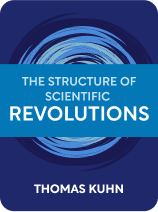

This article is an excerpt from the Shortform book guide to "The Structure Of Scientific Revolutions" by Thomas Kuhn. Shortform has the world's best summaries and analyses of books you should be reading.
Like this article? Sign up for a free trial here .
What are scientific paradigms? What functions do they serve and how do they get established?
Scientific paradigms are the overarching frameworks within a scientific discipline that determine what constitutes legitimate contributions to the field. In that sense, paradigms dictate the problems to be solved and provide the tools with which to solve those problems.
Read on to learn about scientific paradigms, how they get established, and what role they play in the development of science.
What Are Scientific Paradigms?
Without scientific paradigms, it’s hard to know which facts are the most important. Scientists working without a paradigm will tend to gather whatever facts are easiest for them to find, or most relevant to their other areas of knowledge.
Because of this lack of a singular focus or guide, historians tracing a particular field of study back through time would likely find that, before there were common scientific paradigms, each scientist had to recreate the field almost from scratch.
Example: The Study of Light, With and Without Paradigms
For an example of this pattern, let’s look at the history of optics, the study of light. We see a series of scientific revolutions and changing scientific paradigms going back to the 17th century: Modern studies of light are based on the belief that light is made of photons, which have characteristics of both particles and waves. However, before that model was developed in the early 20th century, most physics books taught that light was a wave. If we go back even further, scientists believed light was made of particles and looked for evidence that it puts pressure on solid objects.
However, before the 17th century, there were many competing schools of thought and no one universally-accepted paradigm. There were so many different schools of thought about light because, at the time, there were no common beliefs or understandings that they could take for granted. Due to the biases and past experiences each scientist brought, they came to wildly different—but equally valid—conclusions. Each school of thought supported itself by pointing to certain observations about the world that it could explain better than the others. Those observations were that school’s paradigms. These different schools all made significant discoveries that helped Newton to create the first almost-universally accepted model of light in the 17th century.
Rules of Scientific Paradigms
While historians can generally find the paradigms of a given community fairly easily, finding the specific rules that community followed is often much harder. For one thing, scientists may follow the same paradigm, but disagree on how to interpret it. Also, like professionals in any field, scientists have experience and knowledge that they either don’t communicate clearly or don’t realize others lack. Therefore, historians sometimes don’t recognize or understand the rules of the time because they’re couched in unfamiliar terms and assumptions.
Finally, just because there is a paradigm doesn’t mean that there is necessarily a set of rules to go with it. Sometimes historians are looking for something that simply isn’t there. However, even when paradigms lack specific rules, they can still restrict the scientific field by guiding the work.
To illustrate this point, consider a question asked by the philosopher Ludwig Wittgenstein. He wondered how we know to apply terms like “chair,” or “game,” to something we’ve never seen before.
The brief version of the answer is that we apply those terms to things that resemble other things we know by those names. For example, if something has legs and a seat and a back, then we’ll probably call it a chair because it looks a lot like other chairs. This holds true even if it’s a type of chair we’ve never seen before.
Applying Wittgenstein’s idea to science, scientists following the same paradigm will end up using the same (or similar) terms and methods in their work. Just like we can clearly identify a chair despite there being no concrete laws of “chair-ness,” we can identify a single paradigm by similarities in research methods and the language they use.
There are several reasons to believe that paradigms guide work even when no fixed rules are in place. First, there’s the difficulty of finding concrete rules in some communities, which we’ve already discussed. Second, scientists aren’t given lists of rules and theories to memorize—they pick them up naturally through study and learning how to apply them in practice. In other words, even when such rules exist, they aren’t formalized.
Third, as long as there is a universally-accepted paradigm—or close enough to one—normal science doesn’t need established rules. The scientists all agree on the problems and solutions that their field has, so they’ll naturally work in the same or similar ways, as was demonstrated in the analogy to Wittgenstein’s question. However, the other side of this coin is that normal science does need concrete rules when a paradigm is unstable; in other words, just before and during a scientific revolution.
Finally, normal science—even within the same field—isn’t completely uniform. There could be any number of specialties and subspecialties that, to an outsider, seem to fall under the umbrella of one particular field.
Sometimes a scientific revolution can actually be very small, affecting only a particular specialty within a field. Therefore, there can’t be scientific rules that affect the entire field, when paradigms can change for subsets of that field. The next section will go into detail about subsets within fields and how paradigms can affect them differently.
Anomalies and Discoveries
Normal science doesn’t look for anomalies or unexplained phenomena, but it often finds them anyway; in fact, science seems to be uniquely good at finding unexpected things. In order to mesh those apparently contradictory facts, we have to assume that working within a paradigm is an effective way to change that paradigm.
Working by a particular set of rules, then finding facts or theories that don’t fit those rules, requires that the rules then be changed. Far from unusual or contradictory, this may actually be an inevitable result of digging ever-deeper into a particular paradigm, trying to expand and clarify each tiny facet of it.
There are two key ways a paradigm can be changed: discovering new facts and inventing new theories. However, the two processes are closely related, and both follow the same pattern.
Discovering New Facts and Inventing New Theories
New discoveries start with anomalies. When an observation doesn’t match the expectations set by the current paradigm, there is an anomaly; in that sense, a paradigm is actually needed for new discoveries. You must know what to expect before you can recognize that something’s wrong.
However, anomalies don’t always lead to new discoveries—as we’ve said before, sometimes they’re ignored or brushed aside as mistakes, edge cases, or something too inconvenient to deal with. It usually takes some time for scientists to recognize and acknowledge that the anomaly is important, and must be addressed. Sometimes that never happens at all.
After finally being acknowledged, the anomaly is investigated. Assuming that the anomaly is natural, and not the result of human error, a change in paradigm is needed to account for it.
This process ends when the paradigm has changed so that the anomalous event is now expected. This is more difficult than it sounds. At this point scientists aren’t just adding new knowledge, they’re rejecting old knowledge, and many of their colleagues will resist the change. That resistance to change is part of why discovery and paradigm changes are such drawn-out processes.
A psychological experiment helped to demonstrate this effect. In the experiment, subjects were shown a series of playing cards. However, some of the cards were altered, such as a black four of hearts. Subjects identified the familiar cards easily, but hesitated with the ones that were outside their normal experience of playing cards—that is to say, the anomalies.
Some subjects even became upset by the anomalous cards; they started doubting what they were seeing or how they were interpreting it rather than realizing that it was simply an altered card. Others would incorrectly identify the black four of hearts as either a normal four of hearts, or the four of spades. They immediately and without thinking tried to fit it into their current paradigm of playing cards.
However, when shown the cards a second time, most subjects were able to recognize what had happened and correctly identify all of the cards, including the anomalies. This is a parallel to scientists recognizing that they had not made a mistake, and that their paradigm needs to be adjusted.
Joseph Priestley collected a sample of oxygen-enriched air, but not pure oxygen. He tried to claim that he had discovered the element, but if bottling impure air is enough to take the credit, then he was hardly the first to do so. Plus, it was several years before Priestley even understood what he had bottled; at first he thought it was nitrous oxide, a type of gas that scientists already knew about.
Antoine Lavoisier was the first to collect and correctly identify a sample of pure oxygen, and so he is the one usually credited with discovering it. Some scientists even argue against this claim, since Lavoisier didn’t fully understand how oxygen gas was made. However, the paradigms that led Lavoisier to incorrectly identify how oxygen was produced weren’t rejected until almost a century later, and by that point oxygen itself was firmly entrenched in chemistry.
So you see how it can be difficult to pinpoint what should be a straightforward answer. In fact, the deeper you look into the history of oxygen gas, the less clear it becomes who deserves the credit for discovering it.

———End of Preview———
Like what you just read? Read the rest of the world's best book summary and analysis of Thomas Kuhn's "The Structure Of Scientific Revolutions" at Shortform .
Here's what you'll find in our full The Structure Of Scientific Revolutions summary :
- How scientific paradigms evolve and become replaced with new paradigms
- Why science is more about figuring out what isn't right
- How throwing out past achievements allows for scientific progress






